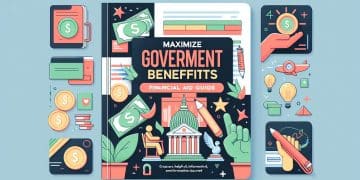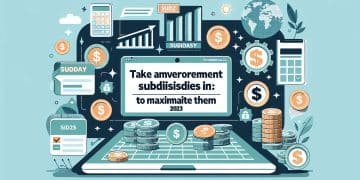Unlocking Financial Aid: A Guide to Navigating Government Subsidies

Anúncios

In an era of economic uncertainty, rising living costs, and fluctuating job markets, government subsidies have become a vital safety net for millions of people around the world.
These financial aids are designed to support citizens, businesses, and communities by reducing the financial burden of essential expenses such as housing, education, healthcare, and energy. However, despite their importance, many people are unaware of the benefits available to them or struggle to navigate the complex application processes that often accompany public assistance programs.
This article serves as a comprehensive guide to understanding, locating, and successfully applying for government subsidies. Whether you are a student seeking tuition support, a small business owner recovering from economic shocks, or a household trying to offset rising energy bills, this guide will help you unlock the financial aid you deserve.
1. Understanding the Concept of Government Subsidies
At its core, a government subsidy is a financial contribution from the public sector intended to promote economic and social welfare. Subsidies can take many forms—direct cash payments, tax reductions, low-interest loans, or price supports—and are typically funded by national or local government budgets.
Governments provide subsidies for several reasons:
-
Promoting social equity – ensuring all citizens have access to education, housing, and healthcare.
-
Stimulating economic growth – supporting businesses in strategic sectors like agriculture, renewable energy, or technology.
-
Encouraging behavioral change – motivating individuals and companies to adopt eco-friendly or socially responsible practices.
-
Crisis relief – helping families and companies survive during periods of economic instability, such as the COVID-19 pandemic.
Essentially, subsidies are not “free money” but strategic investments that aim to balance economic opportunity, innovation, and fairness across society.
2. Common Types of Government Subsidies
a) Education Subsidies
Education remains one of the most heavily subsidized sectors globally. Programs such as federal student grants, loan forgiveness schemes, and scholarships aim to ensure that financial barriers do not prevent talented individuals from pursuing higher education.
In the United States, for instance, the Pell Grant supports low-income undergraduates, while the Public Service Loan Forgiveness (PSLF) program cancels student debt for professionals working in government or non-profit sectors. Other countries offer tuition-free education or reduced fees for students in public universities.
b) Housing Subsidies
Affordable housing programs are essential for low- and middle-income households. Governments often provide rental assistance, down payment grants, or low-interest mortgages through initiatives such as the U.S. Section 8 Housing Choice Voucher Program or the U.K.’s Help to Buy Scheme.
These programs not only help families find secure homes but also stabilize housing markets and reduce homelessness.
c) Healthcare Subsidies
Health is a cornerstone of social welfare. Through Medicaid, Medicare, and similar public insurance models, governments subsidize medical costs for vulnerable populations. Subsidized healthcare helps ensure that citizens receive preventive care, reducing long-term national healthcare expenditures.
d) Energy and Environmental Subsidies
To encourage sustainable practices, many governments provide subsidies for renewable energy, electric vehicles, and energy-efficient appliances. These incentives not only combat climate change but also help consumers reduce monthly utility bills.
For example, tax credits for installing solar panels or purchasing electric cars can offset thousands of dollars in costs while promoting cleaner energy solutions.
e) Business and Agricultural Subsidies
Small businesses and farmers often rely on government support to remain competitive. Agricultural subsidies stabilize food production and prices, while small-business grants and low-interest loans promote innovation, job creation, and economic resilience.
During the pandemic, programs like the Paycheck Protection Program (PPP) in the U.S. provided critical lifelines for entrepreneurs and workers alike.
3. How to Find Government Subsidy Programs
Finding the right subsidy begins with research. Many people miss out on available programs simply because they don’t know they exist. Here’s how to start your search:
a) Visit Official Government Websites
Most governments maintain centralized portals that list all available assistance programs. In the U.S., Benefits.gov allows users to filter programs based on personal needs such as housing, education, or health. Similarly, the European Union Funding & Tenders Portal offers searchable listings for businesses and research projects.
b) Check Local and Regional Programs
In addition to national subsidies, state, provincial, or municipal governments often run their own aid programs. Local programs are sometimes easier to access and offer faster processing times.
c) Explore Non-Governmental Partners
Some subsidies are distributed through partner organizations, such as banks, universities, or community development agencies. These partners often simplify the process by guiding applicants through documentation and eligibility checks.
d) Use Financial Aid Calculators
Online tools can help you determine what kind of assistance you may qualify for. Many universities, for example, have financial aid estimators that predict grant amounts based on your income and family size.
4. Eligibility Criteria and Documentation
Eligibility for government subsidies varies by program but generally depends on a few common factors:
-
Income level: Many programs are means-tested, meaning eligibility is based on household income.
-
Employment status: Some benefits are reserved for unemployed or underemployed individuals.
-
Citizenship or residency: Only citizens or permanent residents may qualify for certain subsidies.
-
Purpose of aid: The program may target specific expenses—like tuition, rent, or energy use.
You’ll usually need to provide documentation such as:
-
Proof of income (e.g., pay slips, tax returns)
-
Identification documents (e.g., ID card, social security number)
-
Residency or lease agreements
-
In some cases, business registration or project proposals for entrepreneurial subsidies
Having these documents ready will speed up your application process and increase your chances of approval.
5. The Application Process: Step-by-Step
-
Identify relevant programs: Match your financial needs to existing government schemes.
-
Review eligibility: Carefully read all program requirements to ensure you qualify.
-
Gather documentation: Collect all necessary papers before starting your application.
-
Submit your application: Apply online or through designated offices. Many programs now allow digital submissions for faster processing.
-
Follow up: Keep track of your application status. Some programs require interviews or additional paperwork.
-
Receive and manage funds: Once approved, use your subsidy strictly for its intended purpose—whether paying tuition, rent, or investing in your business.
6. Tips for Maximizing Your Chances of Approval
-
Apply early: Funding pools are often limited and operate on a first-come, first-served basis.
-
Provide accurate information: Misreporting or incomplete applications are a leading cause of rejection.
-
Seek expert guidance: Financial advisors or nonprofit organizations can assist with complex applications.
-
Stay updated: Government programs frequently change or renew annually—subscribe to newsletters or alerts.
-
Leverage multiple programs: You can often combine several subsidies (e.g., housing + energy + childcare) for greater overall benefit.
7. Managing and Renewing Your Benefits
Once you receive aid, it’s important to manage it responsibly. Keep detailed records of how funds are spent and adhere to all program requirements. Some subsidies require periodic renewal or reporting, particularly for ongoing benefits such as housing or childcare support.
Failing to meet renewal deadlines or reporting obligations could result in suspension or repayment demands. Always read your approval letter carefully and set reminders for key dates.
8. Avoiding Common Pitfalls and Scams
Unfortunately, the popularity of financial aid programs has led to an increase in fraudulent schemes. Be cautious of:
-
Unofficial websites asking for fees to “guarantee approval.”
-
Requests for personal banking information over email or phone.
-
Individuals promising faster processing for a payment.
Always verify that you’re using a .gov, .org, or official institutional website, and never share sensitive data without confirming authenticity.
Conclusion: Empowering Yourself Through Knowledge
Accessing government subsidies can feel overwhelming, but with the right information, the process becomes far more manageable. These programs exist to ensure that no one is left behind—whether you’re striving to afford college, keep your small business afloat, or reduce your monthly bills.
By taking the time to research programs, understand eligibility, and prepare complete applications, you can unlock substantial financial support that makes a real difference in your life. Remember: government subsidies are not just relief mechanisms—they are investments in your future stability, growth, and success.





